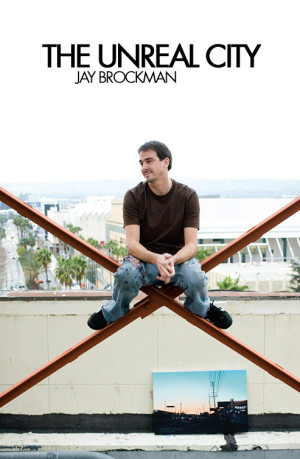
Beneath the humdrum hiccup of her worn city streets, and above hills of fantastical billboards that nearly block any vestige of the sky, Los Angeles speaks. For Jay Brockman, Los Angeles is a subject and a verb as his cityscape paintings reveal his obsession with Sunset Boulevard: a curiosity that sends him driving around Hollywood photographing street scenes from his car. A concrete jungle with no public transportation, LA was designed especially for the motorist. Brockman’s sight seeing expeditions reveal what is most mystifying about LA: for a city built on chance, it’s design is fully realized and made with the intention of being photographed. Whatever message is being uttered beneath our feet, it is the call of the Sirens for Brockman.
The child-like wonderment that consumes him, imparts nostalgia onto his audience. Brockman suggests his work comments on a collective experience about what it means to live in LA. “It’s weird,” he says, “but a picture of LA brings people in LA together.” Hollywood Boulevard, Vine, and Sunset Boulevard are common cityscape subjects, however, it’s not just the nostalgia of work inspired by familiar city streets, rather it is Brockman’s skillful handling of perception and flatness that make his work reflect the way we see LA. From a distance Brockman’s cityscapes appear photo-realistic, almost like a silkscreen rendered from his digital photographs. Upon closer inspection the viewer can identify the hand of the artist through the integrity of the lose brush strokes. Brockman insists on making his work visually compelling by flattening the space, as he explains, “I like the illusion that happens. I see it and I play with that and I definitely like the hand to be a part of my painting because it shows a human being was there. Like the whole painting is my temperament.”
No one walks in LA and appropriately neither does Brockman, who previously lived in NYC. By photographing various parts of the city including Rose and Main, the Capital Records building that spells “Hollywood” in Morse code, and Hollywood Boulevard, Brockman accumulates references for his cityscapes. “I’m my own movie director,” he explains with a grin. Never one to pull over, Brockman points and shoots while driving in traffic. “Other times,” he adds, “I have people drive and I scream Left! Right! Slow down! Go! They’re honking!” Traffic is an integral part of Brockman’s process and also appears in nearly every piece of work. Often times the headlight of a single car twinkles and nearly blinds the viewer, or cars are speeding out of frame and appear as a single streak of black.
Despite the threat of living in perpetual rush hour, Brockman seeks solace following the ebb and flow of Sunset Boulevard, also the name of the 1950 noir classic directed by Billy Wilder. “I didn’t really even get the whole idea of Sunset Boulevard,” he admits. “The sun actually does set. The way the city is set up, there are points in time it’s blinding going down that road, but I don’t know if it was the idea of Hollywood and Sunset Boulevard, but for me Sunset is like a river and it starts from one end to other and it meanders.”
The Sunset on Sunset series, of which there are now sixty pieces and counting, is an aesthetic collision between the slick noir sensibility of Edward Hopper and urban reportage chasing sunsets. Brockman’s group show “Context and Construct” opens on March 28 at Lawrence Asher Gallery and marks his return to painting after a two- year hiatus.
The desire to capture a LA sunset requires a keen sense of timing, being at the exact place where one can actually see the sun. Sunsets are a site most often unseen by many Angelinos as they often occur while we’re shuffling from our offices to our cars. Trying to contain a sunset in seems almost impossible. Laughing he retorts, “Yeah, it’s true.” The sun “is a cyclical thing that keeps us in tune. The sunset itself is an indicator; either some people are going to relax or other people are going to work. It’s part of our inner dialogue.”
In his frequent visits to Sunset Boulevard, Brockman recognizes the juxtaposition between the landmarks and the billboards. Places like Carneys, the now vacant Tower Records, the Standard and House of Blues exchange a dialogue because they are landmarks etched into our cultural consciousness. The real conversation exists between the billboards, Brockman explains they “create their own dialogue in itself,” a message that we don’t often acknowledge but has nonetheless overwhelmed the urban landscape.
The cityscapes resist identification with a precise painterly trajectory; they’re neither entirely Impressionist or photographic, nor do they mimic the works of David Hockney and Ed Ruscha. Brockman’s works are as subtle and sophisticated as the city he loves to paint. Although there are many artists living in LA, not all of them chose the city as their subject. Brockman suggests that there never “really was an heir apparent,” someone who could identify with LA. However “all artists in LA, wherever they are and whatever they do, just reflect back and are intense reflectors at times.”
Like many of us, Jay Brockman battles his love/hate relationship with LA as he confesses, “there’s something about it that calls you back.” Perhaps LA is built upon the ephemeral ideals and construction reminds us that the city is as fleeting as we are. LA is quickly disappearing from something real into a space more and more unreal. As T.S. Eliot wrote “you cannot say or guess, you know only a heap of broken images.” Brockman’s cityscapes mend our fragmentary vision of the city into one that is ever more elusive.
